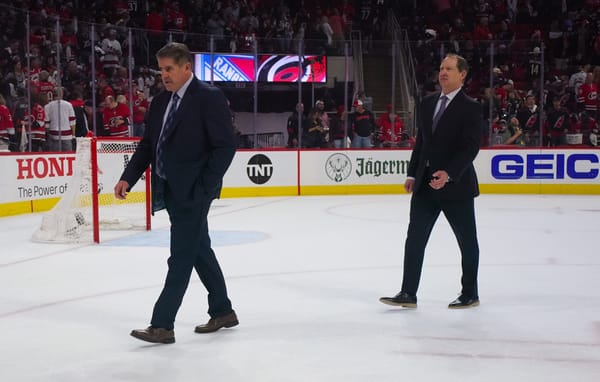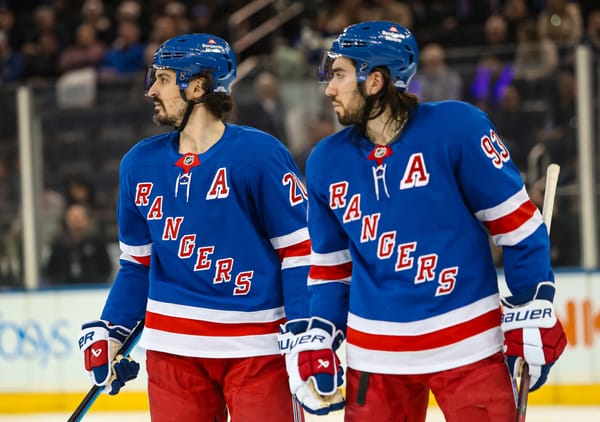Rangers vs. Hurricanes preview: Splitting up Brassard and Zuccarello brings good early returns
Alain Vigneault has gone away from a pairing many assumed to stick together, while small moments have doomed the Rangers of late.
First off, apologies for the lack of notes this morning. Had all the links, and then fell asleep. Wednesdays will get ya.
Entering this season, there were many question marks surrounding how Alain Vigneault would put together his lines. With players like Brad Richards and Benoit Pouliot gone, and then Derek Stepan out an extended period with a leg injury, there were plenty of changes to be made.
Yet one combination that many assumed would remain the same was Derick Brassard and Mats Zuccarello. On a line last season with Pouliot, Brassard and Zuccarello represented tangible chemistry. Most projections included keeping them together, and then adding a player to replace their ex-linemate Pouliot.
Maybe Vigneault reads this blog, or maybe he read the writing on the wall, as the season began 16 and 36 on the same line, flanked by Carl Hagelin. It was reported Brassard even advocated to get the speedy Hagelin on his line to start the season.
But as the Rangers opened against the Blues, the line didn't work. Against St. Louis in that opener, the trio of Brassard, Zuccarello, and Hagelin combined for a -25 Corsi. The Rangers won the game, but the line was underwhelming by all accounts.
In game two of the season, Vigneault kept it status quo. The new Brassard line remained intact, and this time around, they treaded water. It wasn't a dominant, spectacular showing by any stretch, and the line came out dead even in terms of Corsi. Still, it wasn't the kind of performance Vigneault was looking for out of the group, especially considering it was in a loss.
Vigneault's hand was finally forced in game three.
Zuccarello was a late scratch with what some assumed to be a right shoulder injury. Vigneault would have no choice but to split up Brassard and Zuccarello if not only for the reason the latter wasn't available to play.
Not so fast.
Had Zuccarello been available that night, and Vigneault was still ready to pull the trigger, and split up the duo that came into the season with perhaps the most perceived chemistry on the team. In Zuccarello's place was technically J.T. Miller, who was skating on a line with Hagelin and rookie Kevin Hayes. Brassard was grouped with Chris Kreider and Lee Stempniak.
And the results were better. Brassard had one of his better possession games of the season (and that's looking at 5v5 score close, because things went south in that Toronto game, which generally obscures the broader picture), while Stempniak and Kreider both had steady numbers. The trio's 5v5 score close Corsi was a combined +12, a better number than Brassard posted with any linemates all season. Miller, Hagelin, and Hayes were also on the positive end of the spectrum, posting a combined number of +6.
So as Zuccarello returned to the lineup Tuesday night to face the Islanders, Vigneault kept him away from Brassard. Again, looking at the 5v5 score close numbers, Brassard and Zuccarello's new lines shined. (It's fair to point out the entire team posted good possession numbers except for Martin St. Louis' line, but they still had to go out and perform nonetheless.) Brassard's new unit posted a combined Corsi number of +26, while Zuccarello's battering mates along with him ran their number up to +21.
It's easy to ignore possession numbers in these small vacuums, especially as the Rangers continue to drop games. But in a long, 82-game season, these things generally have a way of evening themselves out. When the Rangers got off to a similarly sluggish start in 2013-14, it was hockey's number-crunchers who predicted the team's ineptitude wasn't sustainable, and that their ability to drive possession would eventually begin to equal wins.
What's more is, in watching these Rangers losses this season, it's small moments, which lead to bigger sequences that have been the problem. If one was to isolate the 10 minute stretch in the second period of the home-opener during which the Rangers conceded five goals, and just about every meaningful statistic would have been tilted in Toronto's favor. But again, it's just those miscues or bounces: a power play shot from Dion Phaneuf that gets blocked, but kicks out right on the stick of Phil Kessel, or a bouncing puck at the point that eludes Ryan McDonagh, and springs James van Reimsdyk on a breakaway, and leads to a goal that barely trickles over the goal line.
There's no consolation for these types of scores. The Rangers aren't given "almost" or "bad luck" points when these stretches doom them. Likewise, against the Islanders, the Rangers were well on their way to a regulation victory. A downright dominant first 38 minutes of the game, including racking up 21 shots on goal in the second period alone, and 37 overall shot attempts, had the Rangers in the driver's seat. Those gaudy totals don't accidentally happen, yet Jaroslav Halak limited the damage to one goal against, and then, one of those bad moments reared its ugly head. Michael Kostka threw a blind pass from behind his own goal into the middle, and in a blink, the Islanders erased a deficit. Kostka turned in a carbon copy of his mistake to open the third, and this time, over a stretch of 10 minutes, the Rangers conceded four goals.
By eliminating those blips, and continuing to turn in stretches of dominant possession, and things will ... gulp ... be absolutely fine. It took Vigneault until about Christmas last season to figure out what lines were the most effective. If that's something he can do quicker this go-around, and New York will already be ahead of schedule.
All stats via War on Ice and Hockey Stats




